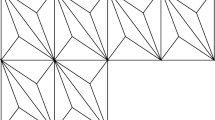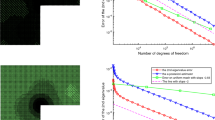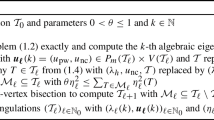Abstract
We introduce a residual error indicator for the Nédélec finite element approximation of the eigenmodes of the Maxwell cavity problem. By using the known equivalence with a mixed problem we prove reliability and efficiency of the error indicator. Numerical results confirm the optimal behavior of an adaptive scheme based on the error indicator.




Similar content being viewed by others
References
Ainsworth, M., Oden, J.T.: A Posteriori Error Estimation in Finite Element Analysis. Pure and Applied Mathematics (New York). Wiley, New York (2000)
Amrouche, C., Bernardi, C., Dauge, M., Girault, V.: Vector potentials in three-dimensional non-smooth domains. Math. Methods Appl. Sci. 21(9), 823–864 (1998)
Babuška, I., Osborn, J.: Eigenvalue problems. In: Ciarlet, P.G., Lions, J.L. (eds.) Handbook of Numerical Analysis, vol. II, pp. 641–787. North-Holland, Amsterdam (1991)
Beck, R., Hiptmair, R., Hoppe, R.H.W., Wohlmuth, B.: Residual based a posteriori error estimators for eddy current computation. M2AN Math. Model. Numer. Anal. 34(1), 159–182 (2000)
Boffi, D.: Fortin operator and discrete compactness for edge elements. Numer. Math. 87(2), 229–246 (2000)
Boffi, D., Brezzi, F., Fortin, M.: Mixed Finite Element Methods and Applications, Volume 44 of Springer Series in Computational Mathematics. Springer, Heidelberg (2013)
Boffi, D., Fernandes, P., Gastaldi, L., Perugia, I.: Computational models of electromagnetic resonators: analysis of edge element approximation. SIAM J. Numer. Anal. 36(4), 1264–1290 (1999)
Boffi, D., Gallistl, D., Gardini, F., Gastaldi, L.: Optimal convergence of adaptive FEM for eigenvalue clusters in mixed form. Math. Comput. 86(307), 2213–2237 (2017)
Boffi, D., Gardini, F., Gastaldi, L.: Some remarks on eigenvalue approximation by finite elements. In: Blowey, J., Jensen, M. (eds.) Frontiers in Numerical Analysis—Durham 2010, Volume 85 of Lect. Notes Comput. Sci. Eng., pp. 1–77. Springer, Heidelberg (2012)
Boffi, D., Gastaldi, L., Rodríguez, R., Šebestová, I.: Residual-based a posteriori error estimation for the Maxwell’s eigenvalue problem. IMA J. Numer. Anal. (2017). https://doi.org/10.1093/imanum/drw066
Cancès, E., Dusson, G., Maday, Y., Stamm, B., Vohralík, M.: Guaranteed and robust a posteriori bounds for Laplace eigenvalues and eigenvectors: conforming approximations. SIAM J. Numer. Anal. 55(5), 2228–2254 (2017)
Carstensen, C., Gedicke, J.: Guaranteed lower bounds for eigenvalues. Math. Comput. 83(290), 2605–2629 (2014)
Chen, Z., Wang, L., Zheng, W.: An adaptive multilevel method for time-harmonic Maxwell equations with singularities. SIAM J. Sci. Comput. 29(1), 118–138 (2007)
Cochez-Dhondt, S., Nicaise, S.: Robust a posteriori error estimation for the Maxwell equations. Comput. Methods Appl. Mech. Eng. 196(25–28), 2583–2595 (2007)
Costabel, M., Dauge, M., Martin, D., Vial, G.: Benchmark computations for Maxwell equations for the approximation of highly singular solutions. https://perso.univ-rennes1.fr/monique.dauge/core/index.html (2016)
Creusé, E., Nicaise, S., Tang, Z.: Helmholtz decompositions of vector fields with mixed boundary conditions and an application to a posteriori finite element error analysis of the Maxwell system. Math. Methods Appl. Sci. 38(4), 738–750 (2015)
Douglas Jr., J., Roberts, J.E.: Mixed finite element methods for second order elliptic problems. Math. Appl. Comput. 1(1), 91–103 (1982)
Durán, R.G., Gastaldi, L., Padra, C.: A posteriori error estimators for mixed approximations of eigenvalue problems. Math. Models Methods Appl. Sci. 9(8), 1165–1178 (1999)
Durán, R.G., Padra, C., Rodríguez, R.: A posteriori error estimates for the finite element approximation of eigenvalue problems. Math. Models Methods Appl. Sci. 13(8), 1219–1229 (2003)
Gallistl, D.: An optimal adaptive FEM for eigenvalue clusters. Numer. Math. 130(3), 467–496 (2015)
Garau, E.M., Morin, P., Zuppa, C.: Convergence of adaptive finite element methods for eigenvalue problems. Math. Models Methods Appl. Sci. 19(5), 721–747 (2009)
Gardini, F.: Mixed approximation of eigenvalue problems: a superconvergence result. M2AN Math. Model. Numer. Anal. 43(5), 853–865 (2009)
Lehoucq, R.B., Sorensen, D.C., Yang, C.: ARPACK Users’ Guide. Solution of Large-Scale Eigenvalue Problems with Implicitly Restarted Arnoldi Methods, Volume 6 of Software, Environments, and Tools. Society for Industrial and Applied Mathematics (SIAM), Philadelphia (1998)
Monk, P.: A posteriori error indicators for Maxwell’s equations. J. Comput. Appl. Math. 100(2), 173–190 (1998)
Nédélec, J.-C.: Mixed finite elements in \({ R}^{3}\). Numer. Math. 35(3), 315–341 (1980)
Nicaise, S.: On Zienkiewicz–Zhu error estimators for Maxwell’s equations. C. R. Math. Acad. Sci. Paris 340(9), 697–702 (2005)
Nicaise, S., Creusé, E.: A posteriori error estimation for the heterogeneous Maxwell equations on isotropic and anisotropic meshes. Calcolo 40(4), 249–271 (2003)
Raviart, P.-A., Thomas, J.M.: A mixed finite element method for 2nd order elliptic problems. In: Mathematical Aspects of Finite Element Methods (Proceedings Conference, Consiglio Naz. delle Ricerche (C.N.R.), Rome, 1975), pp. 292–315. Lect. Notes Math., vol. 606. Springer, Berlin (1977)
Schöberl, J.: A posteriori error estimates for Maxwell equations. Math. Comput. 77(262), 633–649 (2008)
Scott, L.R., Zhang, S.: Finite element interpolation of nonsmooth functions satisfying boundary conditions. Math. Comput. 54(190), 483–493 (1990)
Si, H.: TetGen, a Delaunay-based quality tetrahedral mesh generator. ACM Trans. Math. Softw. 41(2), Art. 11, 36 (2015)
Verfürth, R.: A posteriori error estimates for nonlinear problems. Finite element discretizations of elliptic equations. Math. Comput. 62(206), 445–475 (1994)
Verfürth, R.: A Posteriori Error Estimation Techniques for Finite Element Methods. Numerical Mathematics and Scientific Computation. Oxford University Press, Oxford (2013)
Zhong, L., Chen, L., Shu, S., Wittum, G., Xu, J.: Convergence and optimality of adaptive edge finite element methods for time-harmonic Maxwell equations. Math. Comput. 81(278), 623–642 (2012)
Acknowledgements
First author gratefully acknowledges the hospitality of University of Concepción (Departamento de Ingeniería Matemática and CI\(^2\)MA) during his visit on January 2016. First and second authors were partially funded by IMATI-CNR and GNCS-INDAM. Third author was partially supported by BASAL project CMM, Universidad de Chile (Chile). Fourth author was supported by Fondecyt Postdoctoral Grant No. 3150047, CONICYT (Chile).
Author information
Authors and Affiliations
Corresponding author
Rights and permissions
About this article
Cite this article
Boffi, D., Gastaldi, L., Rodríguez, R. et al. A Posteriori Error Estimates for Maxwell’s Eigenvalue Problem. J Sci Comput 78, 1250–1271 (2019). https://doi.org/10.1007/s10915-018-0808-5
Received:
Revised:
Accepted:
Published:
Issue Date:
DOI: https://doi.org/10.1007/s10915-018-0808-5




